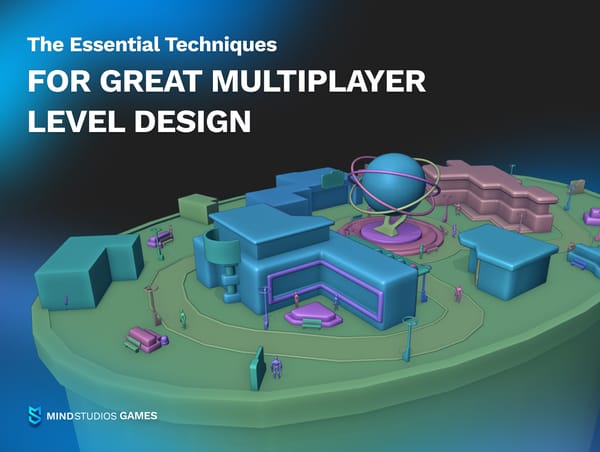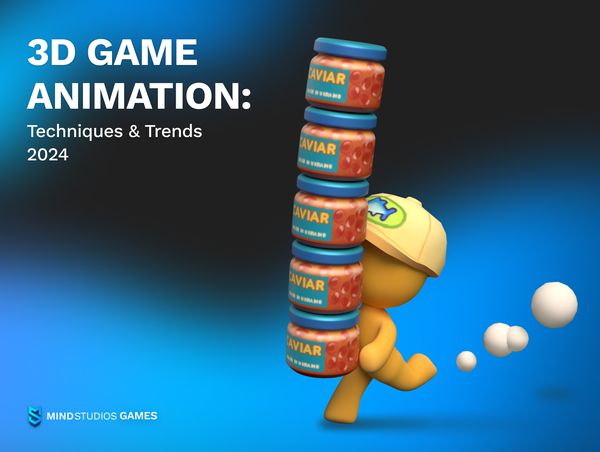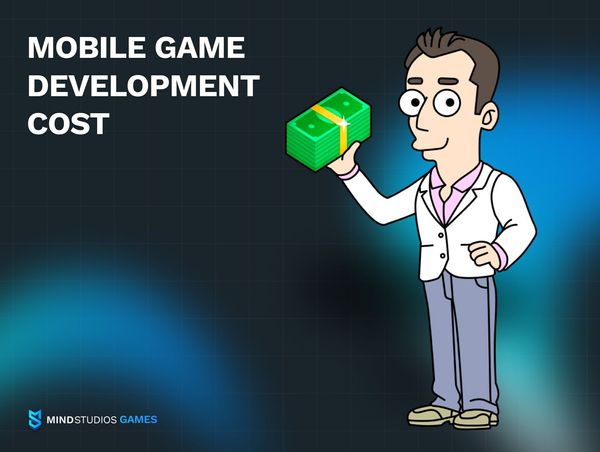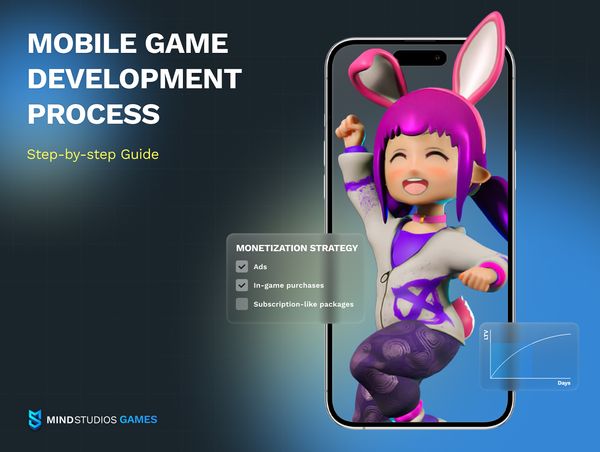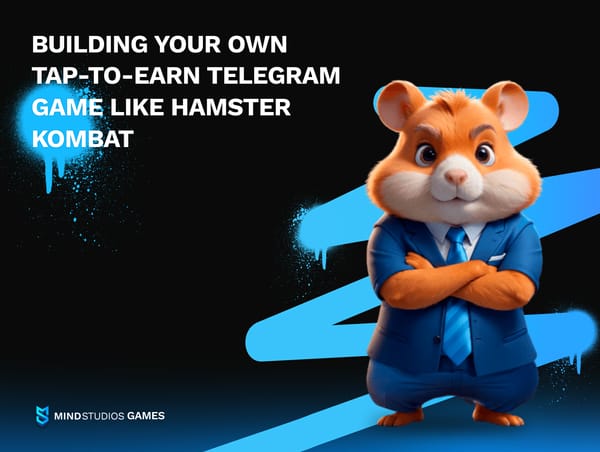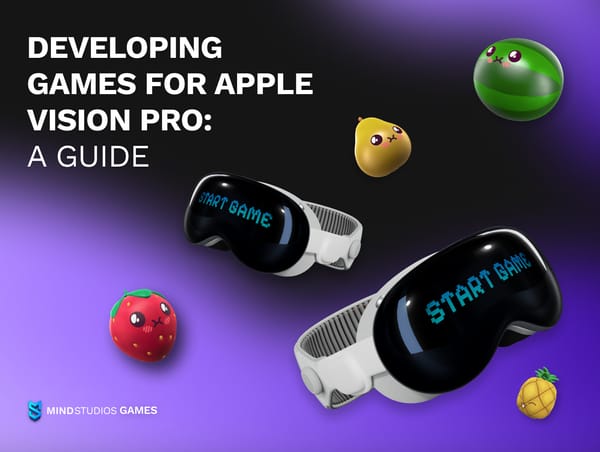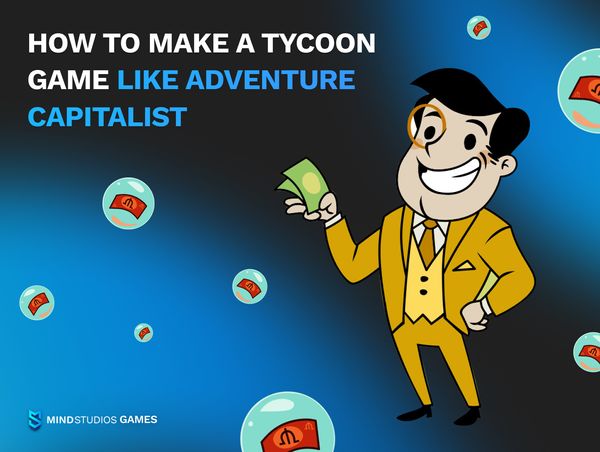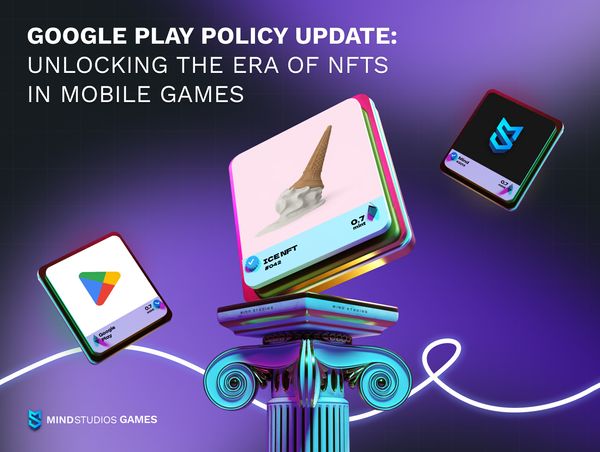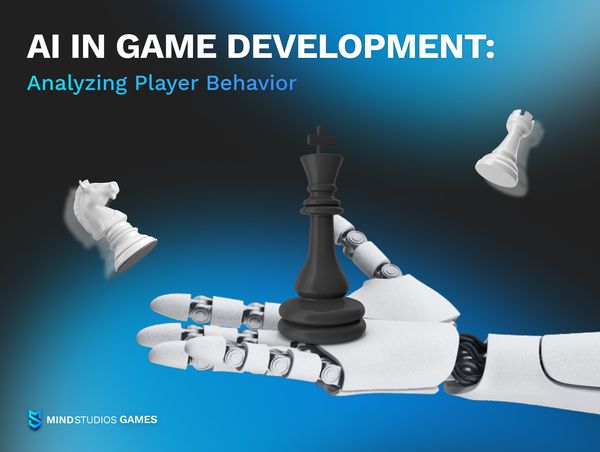When a top-shelf game idea springs into your mind, one of the first things you will probably think about is “How do I hire a game development team that can help me bring this to life?”
Game ideas can come to anyone who loves games — gamers, developers, artists, writers, and business people alike can get an inspiration. However, some of us are lacking the experience of finding proper contractors to entrust these ideas to. Where and how to find a game development team? What specialists to include? What to pay extra attention to? How much the specialists cost? All this can be a bit overwhelming.
Well, here’s your guide to this complex but very exciting (in our biased opinion) process.
Below, you will find an explicit description of what a full game development team looks like, places to look for specialists — separately or as a team — and advice on how to handle the process so that your game goes live successfully.
Key highlights:
- It’s possible to build a great video game with a small team if you include all core specialists
- Our clients often undertake certain roles in game development themselves — such as game producer or marketing manager — to cut costs
- It’s important to have a clear vision of your game idea before you hire a game development team
- Good communication goes a long way in ensuring that your game is launched on time, is of high quality, and fits into your budget
Key roles in a game development team
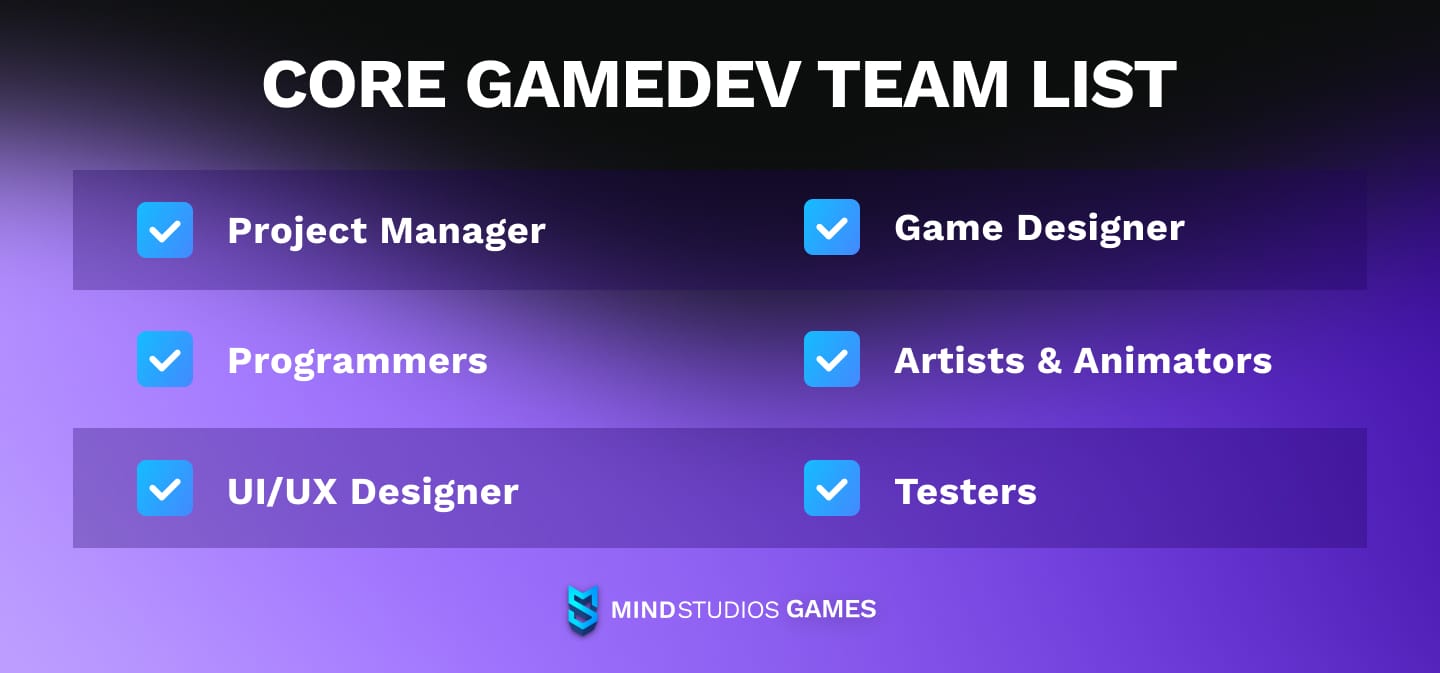
Creating a video game is a complex process that involves various specialists working together to bring a concept to life. That’s news to no one, probably. While it is possible today to be a one man (or woman) team, if you want your game to make it big out there, it’s better to have professionals covering each role. Otherwise, the focus might be spread too thin and the probability of making mistakes grows exponentially.
A typical game development team consists of professionals with diverse skill sets, each playing a role in different aspects of the game's creation. Below, we offer you a game development team structure — a breakdown of the key positions in a game development team, along with their responsibilities and the importance of their roles.
Project manager (PM)
The project manager is overseeing the entire game development process. This includes managing the schedule, budget, and communication among team members. They ensure that the project stays on track and meets deadlines.
A PM is crucial for project management and coordination. They keep the team focused and aligned with the project's goals, ensuring a smooth development process and timely delivery.
Game and level designers
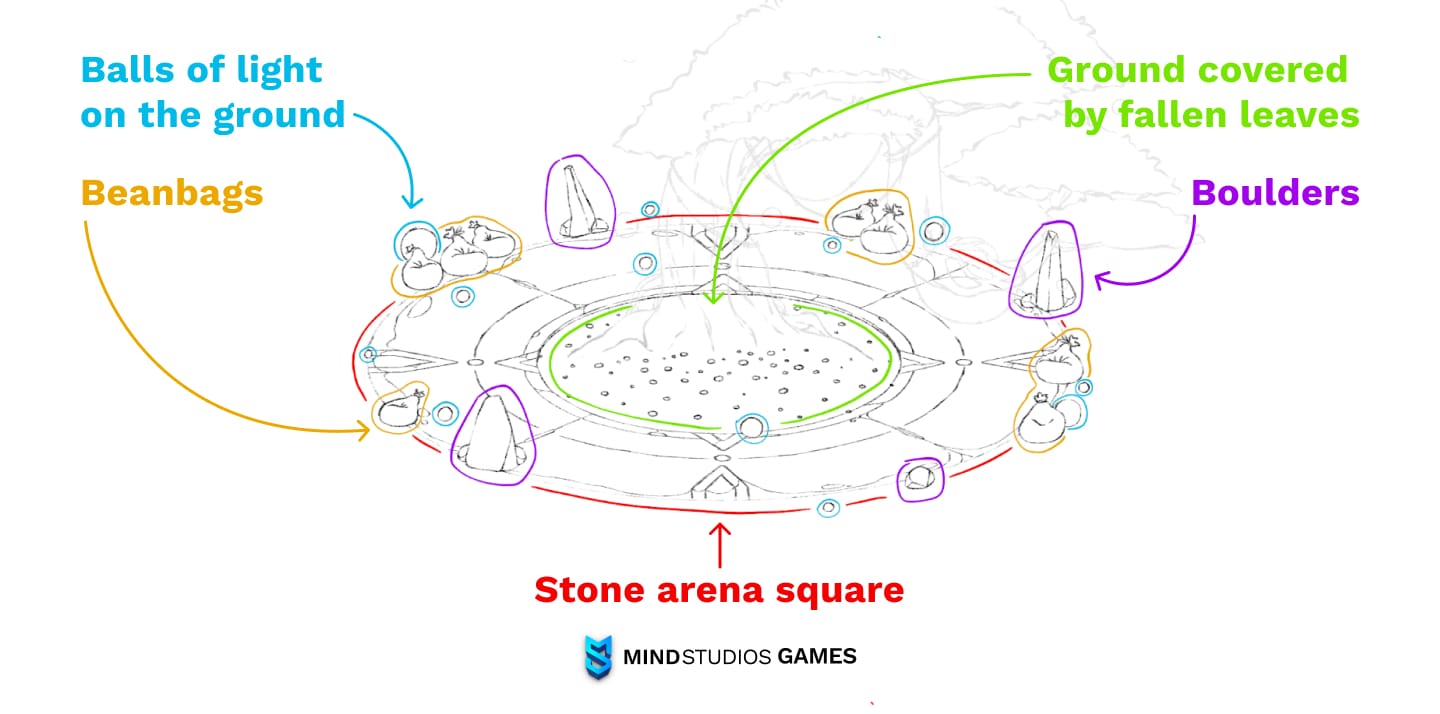
The responsibilities of a game designer are designing the core mechanics, rules, overall story, and sometimes levels of the game. They create the game's concept, gameplay elements, and draft user journey. The results of a game designer’s labor is laid out in a game design document (GDD) — a document serving as a guideline for development.
Game designers shape the player's experience and the game's overall vision. A well-designed game can captivate players and provide a memorable experience, while poor design can lead to frustration and disinterest.
In small teams, game designers can also be in charge of creating the game levels, layout, pacing, and challenges. But from a conceptual standpoint, level designers are separate specialists who work closely with game designers and artists to build engaging environments.
Well-designed levels are crucial for keeping players engaged. They provide a structured experience and can greatly influence the game's difficulty and replayability.
Programmers
The most easily understood among game development team roles, programmers (or developers) write the code that brings the game to life. Gameplay programming, graphics rendering, physics simulations, and more are handled by programmers. Their work ensures that the game runs smoothly, is bug-free, and can handle the desired features and performance.
Depending on the type of your game, its intended feature set, graphics, and other characteristics, you might have to choose programmers who work with a specific game engine.
For example, Unreal Engine is often picked for hi-end PC and console games where realistic 3D graphics and animation are important. On the other hand, for many mobile and PC/console games that have slightly lower requirements towards graphics, Unity game engine is a more popular option. The reason for that is a less steep learning curve and more affordable price, coupled with an impressive asset store and active community.
Also, Unity has extensive integration with ad networks, which makes it perfect for free-to-play mobile games. This is why we at Mind Studios Games decided on Unity as our go-to game engine.
Note: Unity’s grasp on graphics quality isn’t inferior to UE’s all that much. Many games that boast highly praised graphics were developed with Unity. One of the realistic-looking titles that comes to mind is Sons of the Forest by Endnight Games. However, Unity’s brand of graphics is better suited for stylized art. Genshin Impact, for example, was developed in Unity, as were Final Fantasy VII: Ever Crisis and Pokémon GO.
Artists and animators
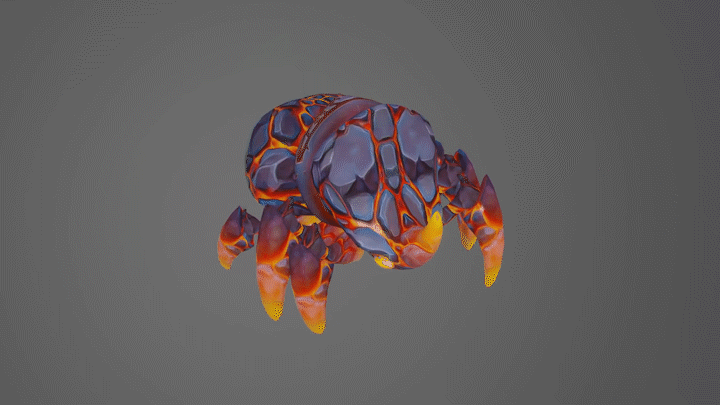
Visuals are a critical aspect of a game's appeal. Good art can draw players into the game world, and poor visuals can demotivate players even if the gameplay is great. Investing in good visuals adds to the game’s potential success a lot.
Characters, environments, objects, animations, and special effects are the domain of artists, who can also be further divided into concept artists, 2D artists and 3D modelers, animators, VFX specialists.
There are also technical artists, who help maintain a balance between visual fidelity and performance. By optimizing graphics, creating shaders, and ensuring that art assets are efficiently integrated into the game engine, they ensure that the game looks good while running smoothly.
Technical artists occupy a unique position that requires a deep understanding of both the artistic and technical aspects of game development. They must be proficient in art creation tools and have a strong grasp of programming and scripting. That’s why, in smaller indie teams, programmers and artists might put their heads together and take this function upon themselves.
UI/UX designers
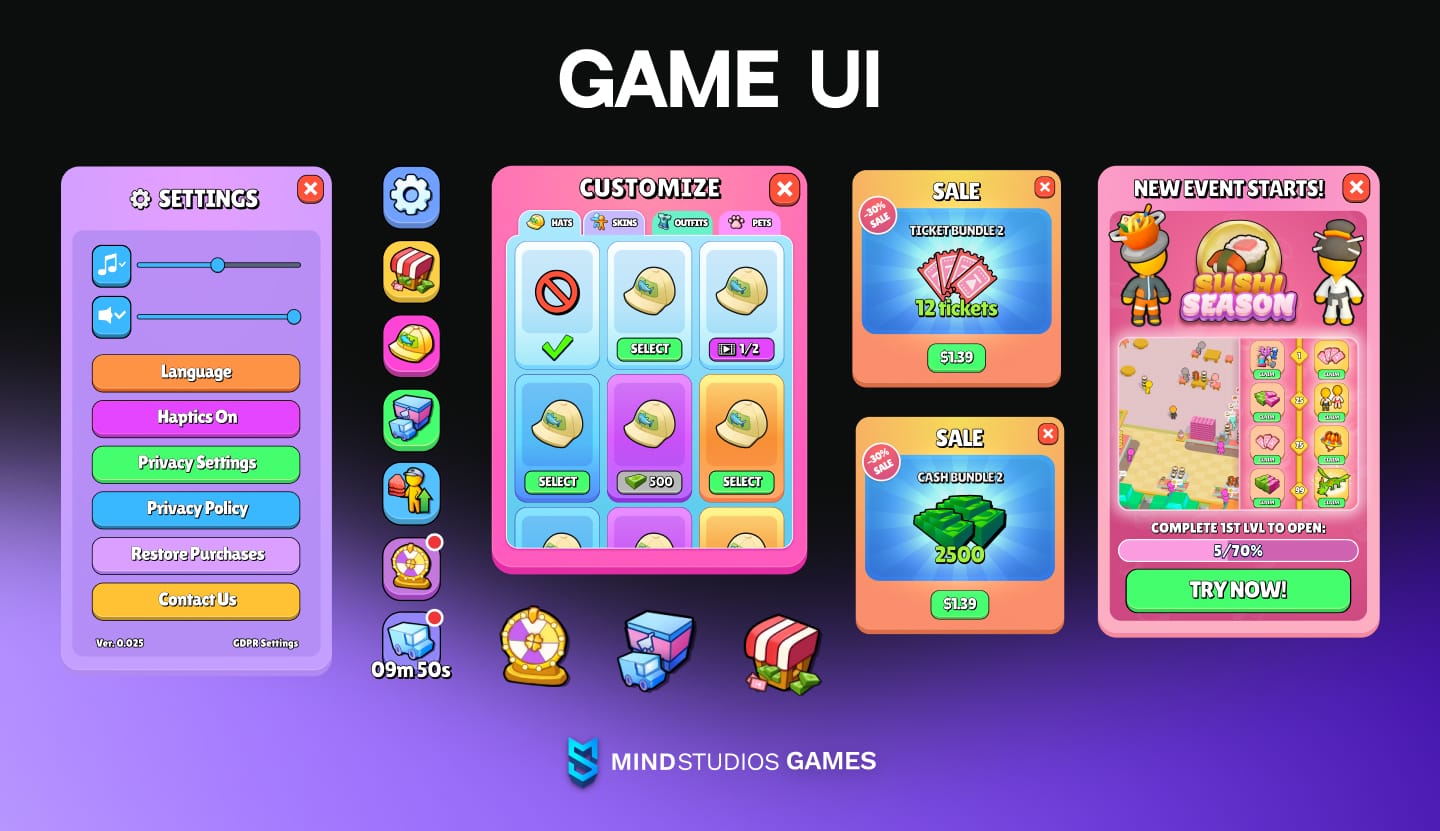
UI/UX design isn’t the same as drawing art, which is why game development team roles include a UI/UX designer separately from artists. Designing the menus and user interfaces requires specialized knowledge: usability, intuitiveness, and player behavior patterns.
Good UI/UX design improves the player's experience by making the game easy to navigate and understand.
Note: UI/UX designers for PC, console, web, and mobile games are likely to be separate people. The principles of UX design for different platforms aren’t the same.
Quality assurance (QA) specialists
QA specialists, commonly known as testers, are absolutely essential for any game’s success. They help ensure that the game is free from bugs and serious issues that could negatively impact the player's experience and the game's reputation. They ensure that the game is polished and functions as intended.
It’s of utmost importance to allocate ample time to testing your game. Nowadays, the game market is saturated with hundreds of titles in any genre and setting imaginable, so a bugged game will be immediately discarded in favor of an alternative.
The positions listed above are considered the core of a game development team — the essential cogs in the wheel. The ones we list below aren’t always included, especially in smaller projects. But if you aim high, and depending on your idea’s specifics, you might want to consider these game development team roles as well.
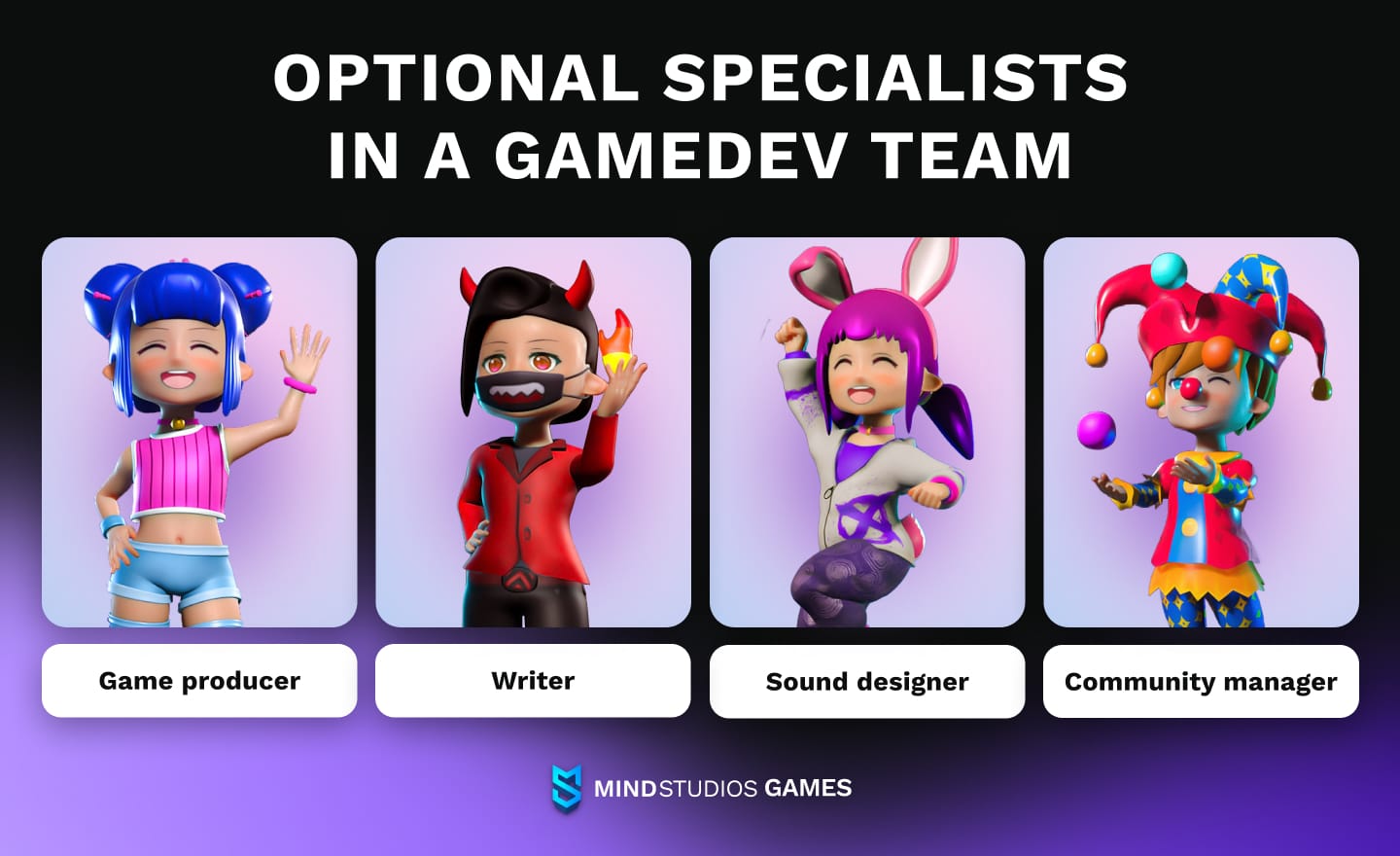
Game producer
Game producer is a position that’s sometimes tricky to describe, as its description overlaps with that of a project manager. However, there are distinctions. The mission of a video game producer is to instill in the team the project’s vision — and monitor the processes so that the final product doesn’t veer off course.
Sounds vague, right? Well, in practical terms, it means that your game producer will need thorough knowledge of:
- the market your game is entering, its standards and trends, your competitors, and platforms to cover
- everything about your target audience — their age, geography, habits (including non-gaming ones like reading preferences), expectations from the game, how to communicate with them, etc.
- possible ways for marketing and how much it will cost
- your (the client’s) goals regarding the game, its profitability and future development
All things considered, you probably won’t be surprised to learn that in outsourced game development, the clients themselves frequently manage the role of a game producer. That’s because no one knows the goals and the market better than a person who came up with the idea. (And probably no one cares as much about the success as the owner of the end product.)
Writers
Here’s one of the roles in a game development team that’s not always present in each game development company. These are people crafting the narratives, dialogue, and in-game text. They work closely with designers to integrate the story into the gameplay.
Today’s game market — especially mobile one — offers a lot of games that require little to no narrative, like idle and hyper-casual games. In small teams specializing in these genres, game designers might be responsible for what little narrative the game does need.
At the same time, a compelling narrative can significantly enhance a game's appeal, providing context and motivation for players. Well-written dialogue and/or story elements can create emotional connections and deepen engagement in even the most simplistic titles. For example, when we added a bit of personality-colored strokes to the onboarding in one of our hybrid-casual games, it increased player retention by 1.5%.
Sound designers and composers
Audio enhances the immersive experience, setting the mood and atmosphere. High-quality sound design can make gameplay more engaging and memorable. Sound designers create the game's audio elements — sound effects, voiceovers, and music. They work on everything from ambient sounds to the soundtrack.
Nowadays, many indie game studios forego in-house sound designers and instead purchase this service from specialized platforms like AudioJungle or Pond5.
Marketing and community managers
Here are the game development team roles that used to be overlooked but became extremely important in the days of the Internet. These days, without promoting your game, engaging with the community, and managing public relations you are in danger of falling into the oblivion abyss of the game market. There’s just too much noise around games and gamers, and if you’re not part of that noise, no one will seek you out.
Marketing managers work on advertising campaigns, social media, and events. They help build hype, manage the game's image, and foster a loyal player base.
Hiring a professional for this is a good idea, but many indie game owners handle this themselves, as learning some strategies and applying them is possible even in the limited time.
Stages of hiring a game development team
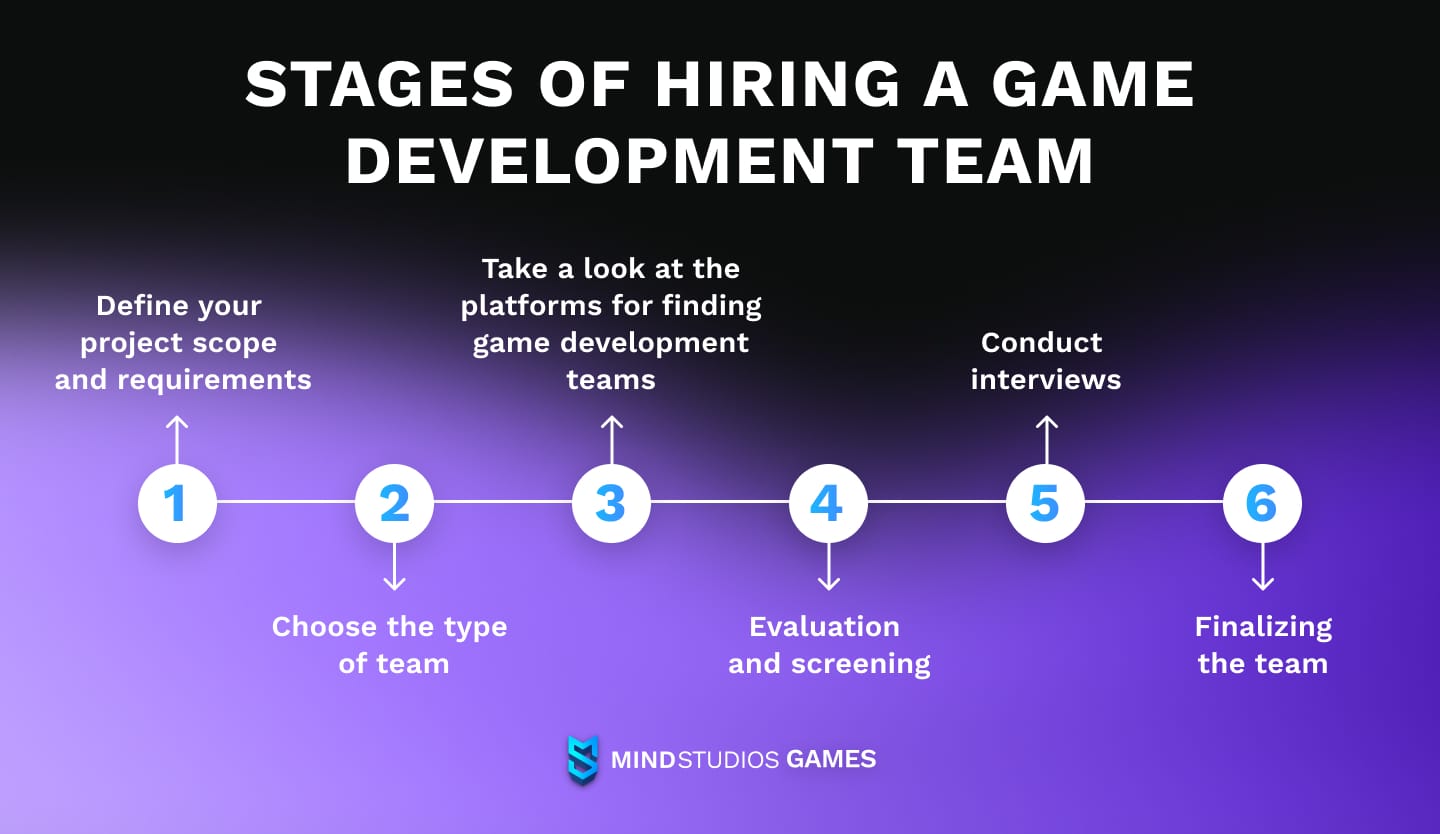
Now that we’ve covered the game development team structure and what specialists might be needed for fast and efficient game development, let’s talk about the main focus of this article: how to hire game developers. This section will cover the main steps of choosing game developers for hire, places where to look for them, and points to keep in mind during the process.
Step 1. Define your project scope and requirements
For the sake of efficiency and to avoid blindly wandering around in the forest that is the game development industry, it’s better to draft a plan of what you want your game to look like in the end. The more details you can come up with, the better. This plan might undergo changes during development — an experienced game dev team will be able to offer advice — but a plan will help you narrow down the selection of possible contractors.
Write down the following:
- Game genre
- Platform(s) you want to offer it on (mobile, Steam, web game)
- Your game’s target audience
- Key features and gameplay mechanics
- Art style (2D or 3D, realistic or stylized, etc.)
- Budget and timeline
- Team roles required (full team or only designers, artists, programmers)
Step 2. Choose the type of team
There are three main types of collaboration with a game development team:
- In-house team — building a team within your company.
- Outsourcing team — hiring an external game development studio or agency.
- Freelancers — collaborating with independent professionals for specific tasks.
An in-house team makes sense if you plan to build multiple games for a long time, as in if you have or aim to establish a game development studio of your own. If the game you’re building is your first (and that’s why you looked up ‘how to find a game development team’ on Google and landed here), an in-house team might be an inefficient solution. You don’t know yet whether you’re in this for a long run, so spending on social benefits, equipment, and long team onboarding will cost too much.
The choice between an outsourcing company and freelancers will depend on your preferences. Many outsourcing game development companies provide the opportunity to hire a game development team full-cycle (as in, full team together), but it’s equally possible to hire only the specialists you need. The benefits of a company are:
- saving time on looking for each role
- the security of an established entity as a partner
- a possibility to bring team members in and out as you need during the project
- fast replacement of specialists in case of emergency (e.g., illness or vacation)
- an option to work based on the fixed price model, knowing from the start how much it will cost to develop your game
Freelancers, however, can sometimes be cheaper to hire. Not always, though 😀
Step 3. Take a look at the platforms for finding game development teams
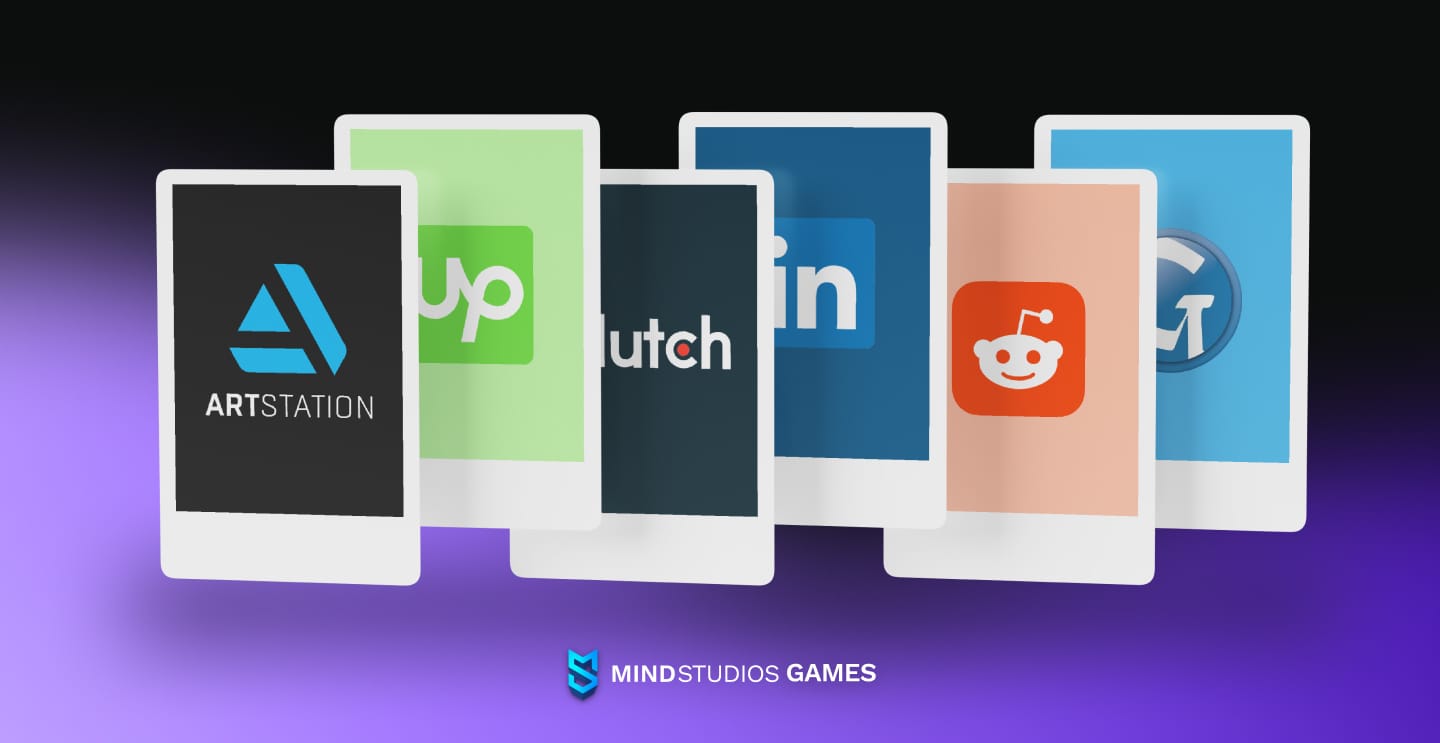
Now, where to look if you want to hire game developers with the outsourcing model (companies or freelancers)? There are options!
Freelance platforms |
Upwork: A platform for hiring freelancers across various fields, including game development. Freelancer: Similar to Upwork, offering a range of freelance services. Toptal: Specializes in connecting clients with top-tier freelancers, including game developers and designers. ArtStation and Behance: Ideal for finding artists and designers. Fiverr: Another platform for freelancers, with offers from all over the spectrum of game development jobs. |
Outsourcing agencies and studios |
Clutch.co: A directory and review site for finding IT and game development companies. GoodFirms: Another directory for finding development firms and agencies. Upwork hosts companies as well as freelancers. GameDev.net and Gamasutra: Communities and job boards focused on the game industry. Google: You can find websites of outsourcing game development companies via search. ArtStation also has a section with studios, not just individual artists. |
Networking and communities |
LinkedIn: For professional networking and finding both individual talent and companies. Reddit (e.g., r/gamedev): Community forums where developers and studios may post job opportunities. Conferences and Meetups: Events like GDC (Game Developers Conference) and Gamescom are excellent for networking and meeting potential hires. |
Speaking of conferences! Mind Studios Games was at the Gamescom conference in Cologne this year, August 21–25, and will be at DevGAMM in Lisbon, on November 14–15. Get in touch with our Head of Gamedev to meet there 🙌🏻
Step 4. Evaluation and screening
After choosing the platform(s) where you’ll be looking for partners, here are the things to check in profiles:
- Portfolio. Assess the quality and style of previous works. Look for either your game’s genre or diversity in projects. It’s also always a good practice to evaluate consistency in quality.
- Technical skills. If you’re looking to hire game programmers, i.e., specialists for technical roles, ensure they have experience with your chosen game engines (Unity, Unreal Engine, etc.), programming languages (C#, C++, etc.), and tools.
- Time zones. For effective management, your working hours need to overlap with those of the team for at least an hour or a couple. This allows for prompt changes and fixes when needed.
- References and reviews. Check past client reviews and references to gauge reliability and professionalism.
- Trial projects. Some game development studios offer to do a small task for free. It could be idea validation, research, concept art sketch, or a prototype demo to prove their skills.
Step 5. Conduct interviews
As a result of screening, you’ll be left with a handful of game developers or studios. The most efficient number would be 5 to 8 options — this way, you can interview all of them within a short timeframe and decide which one you’d work with.
During interviews, if you can gauge the developers’ tech skills, you can do that. However, another important part of choosing a game development team is their cultural fit for your project and the efficiency of communication.
Do they understand your idea correctly? Is their advice sound and based on real data and experience? How do they handle unexpected situations? Are they comfortable to talk to?
Game development can take a lot of time, so it’s essential to have a team with which you’ll have effortless communication and similar values.
Step 6. Finalizing the team
When you’ve narrowed down the selection to two or three options, discuss collaboration terms: payment terms, budget restraints, deadlines, intellectual property rights, and confidentiality. Pick the most suitable team, then set up communication channels, project management tools, and clarify roles and responsibilities.
Congratulations! Now you’re all ready to start creating your game with your new team!
Engagement and communication
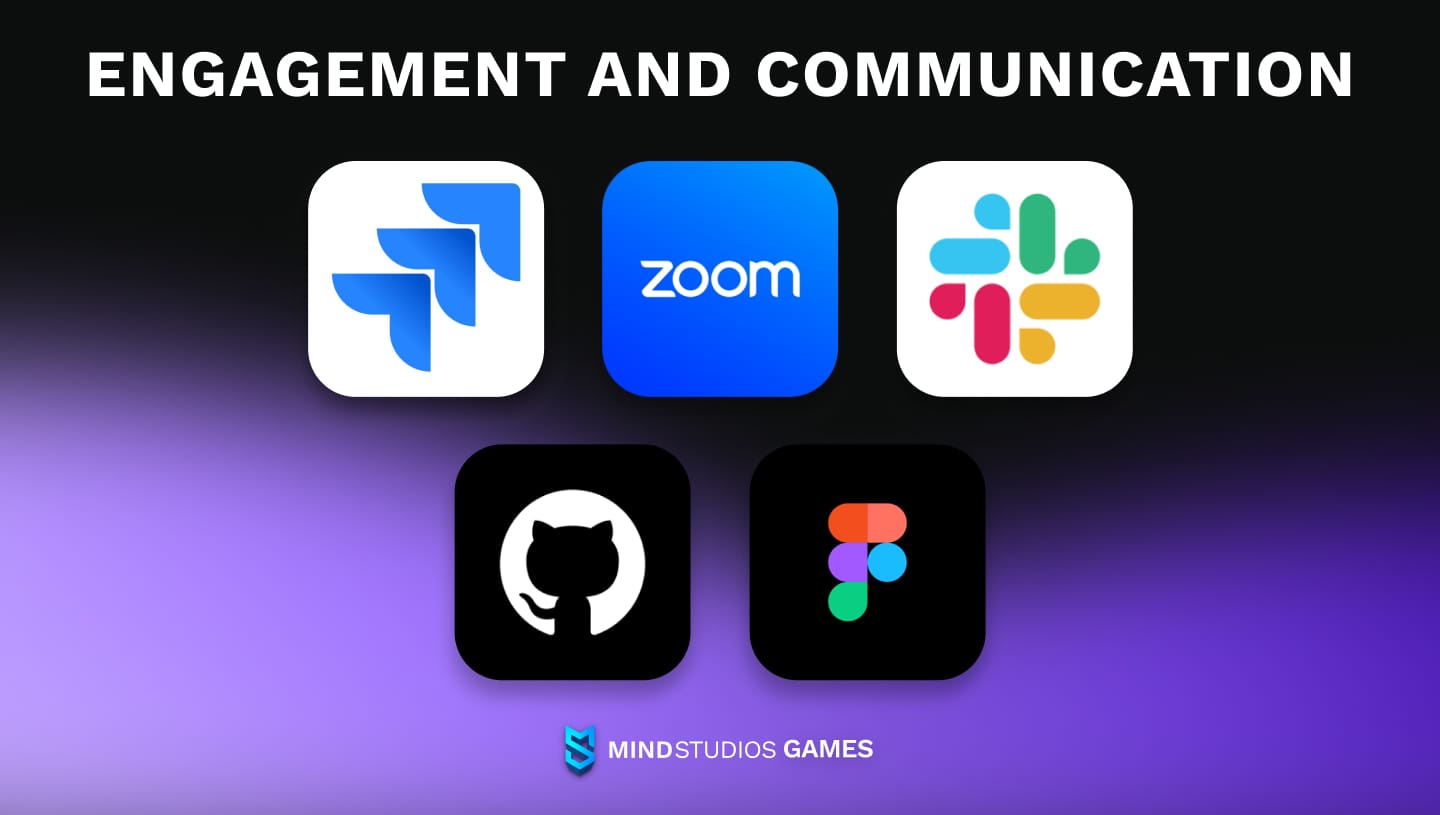
In the previous section, we’ve mentioned that it’s important to have efficient communication with your chosen game development team. Good communication is crucial for the success of any project. It ensures that the client's vision is clearly understood and accurately implemented, while also allowing the team to provide feedback and suggest improvements.
Effective communication helps in setting realistic expectations, managing timelines, and resolving issues promptly. It also fosters a collaborative environment, reduces misunderstandings, and increases the likelihood of delivering a high-quality product on time and within budget.
What methods are there to stay on the same page with your outsourced game developers for hire?
Regular meetings |
Brief meetings online to discuss progress, blockers, and plans. Can happen daily, weekly, once per iteration, etc. The team shall also share interim results with the client at strategic points during development; these sessions are called Demos. |
Written centralized documentation |
Project briefs, specifications, reports, and an always-up-to-date roadmap ensure that detailed information is documented and accessible. Wikis or shared documents to store all project-related information, ensuring everyone has access to the latest updates. |
Feedback loops |
Iterative review sessions where clients provide feedback on deliverables, allowing for continuous improvement. |
Tools you can use for collaboration with the game design team:
- Project management tools. Jira, Trello, Asana: For task tracking, milestone setting, and progress monitoring. They provide a visual representation of the project's status and facilitate task assignments and prioritization.
- Communication platforms. Slack, Microsoft Teams, Discord: for real-time messaging, file sharing, and quick discussions. They help maintain an open line of communication among team members and with the client.
- Video conferencing tools. Zoom, Google Meet, Microsoft Teams: for face-to-face virtual meetings, essential for discussing complex issues and maintaining personal connections.
- Version control tools. Git (GitHub, GitLab, Bitbucket): for version control, ensuring that code changes are tracked and managed. These platforms also support code review and collaboration.
- Design and prototyping tools. Figma, Adobe XD, Sketch: for creating and sharing design mockups and prototypes, facilitating visual communication and feedback.
- File sharing tools. Google Drive, Dropbox: for sharing large files, documentation, and other project-related materials.
Mind Studios Games as your game development partner
Instead of tooting our own horn, we’d like to let our partners do the talking. Here are just some of the warm words we’ve received over the years.
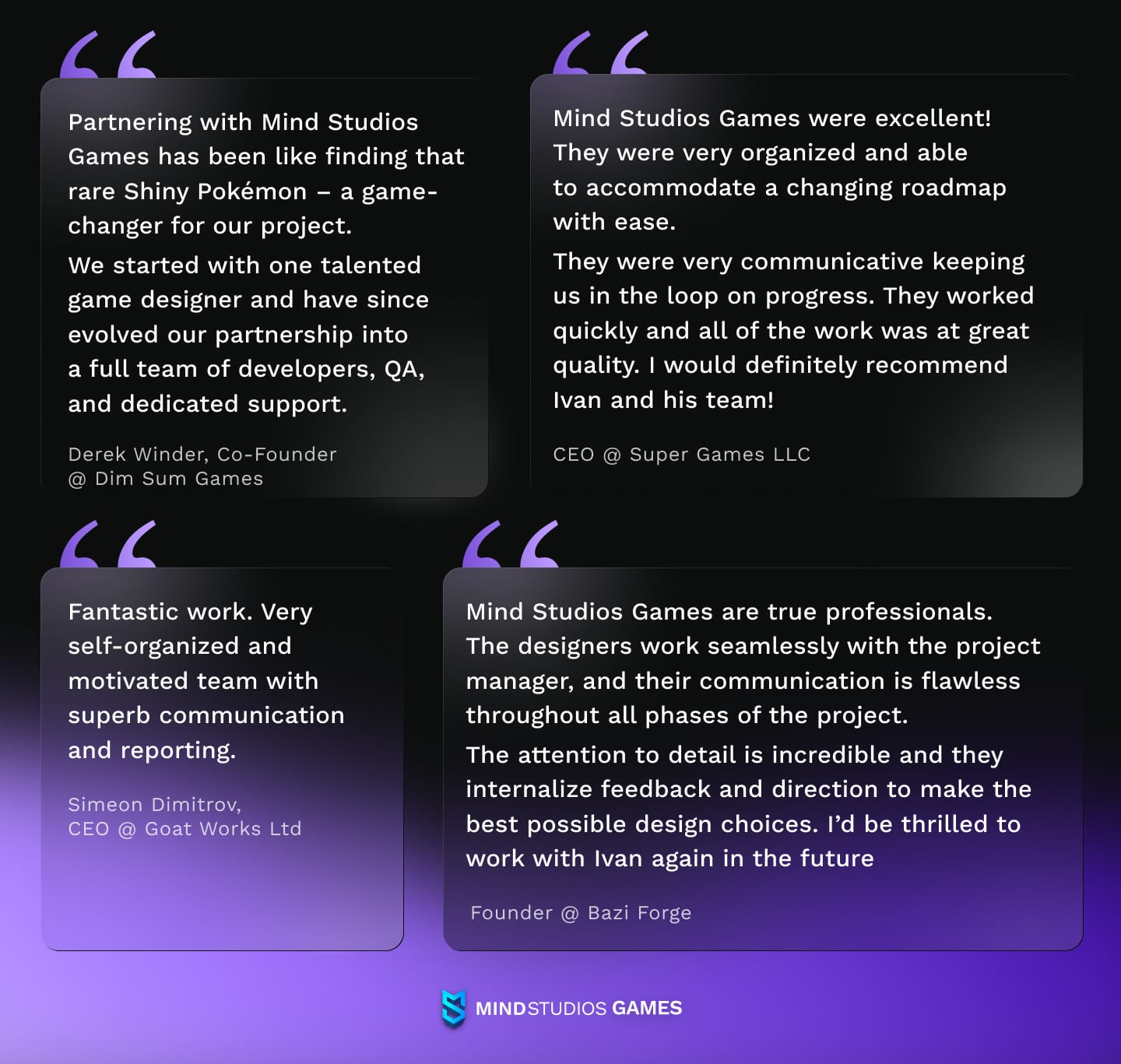
Conclusion
Hiring a team for your game development might seem like a simple task, but it’s not. However, it’s not as daunting as it might appear either: the global network of video game developers provides a wealth of options, but it also allows for easy filtering, if you apply a bit of effort. You can find great partners to hire game developers from even via simple Googling, not to mention a variety of specialized platforms.
If you’re looking for an experienced team of game developers for hire<, get in touch with Mind Studios Games — with our 8+ years on the market, we’ve built a wide range of mobile games in Unity, and we know our way around most of the mobile game development challenges. Sign up for a free consultation in our contact form, and we’ll get back to you with our offers.

